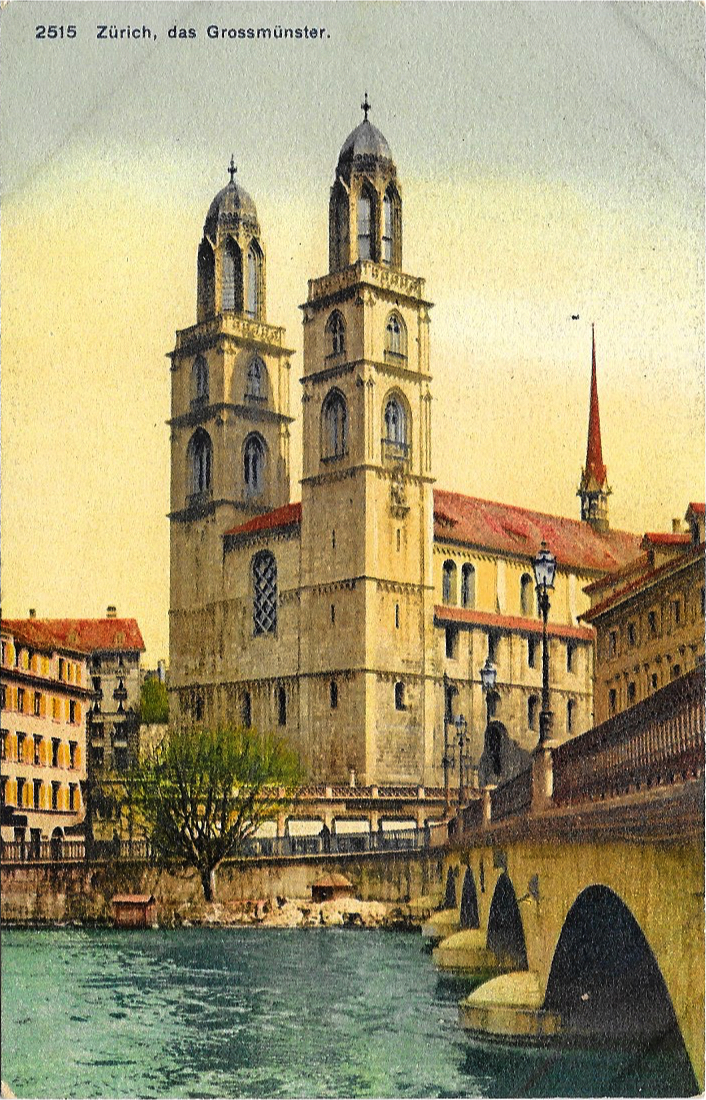
Zürich and the Alps.
Emily and I started for Zürich this morning and were met at the depot by Alfred. Together we went shopping, and I then met an old friend and companion of the days when I worked in the printing office in Bremen. He is a preacher now, his name is Jacob Sporri and he was pleased to see me. We then went to the Swiss National Museum which, although only open some 10 years ago, is the most important collection of the kind in Switzerland.

Zürich. Swiss National Museum.
It contains historical and art industrial objects from prehistoric days down to the 19th century. The collection of Stained Glass, distributed throughout the various rooms, is the best I have seen, and it is considered the best in the world. It is the first time that we have taken time to go through a museum at leisure, stopping whenever and wherever we pleased. Up to now it was always “Hurry on” we haven’t the time to look at everything.
The collection of prehistoric antiquities, containing remains from caves and lake dwellings, also graves from the bronze and iron periods, is very large and interesting, and many of them have been found in and around Zürich, proving that this site was occupied in prehistoric times. Fifty eight years before Christ, it, together with the other towns of the Helvetii, fell under the sway of the Romans, and the collection of Roman vases, ornaments, bronze statues, utensils, stone monuments found in Switzerland is very large. The painted ceiling with scenes from the New Testament, a copy of the one now in the Church of Zillis and dating from the 13th century attracted our attention.
So did a series of rooms set it up with medieval and Renaissance furniture; some of them, as, for instance, the room from the Dominican nunnery of Oestenbach (1521) and the one from the Casa Pestalozzi at Chiavenna, the stateroom from the Seidenhof at Zürich with its beautiful tile stove, and the baroque room from the Lochmann house at Zürich are originals removed to the museum and fit it up with their original furniture.

Switzerland, Swiss National Museum, Zurich.
Room from the Casa Pestalozzi (Chiavenna, 1585)
In these, the wonderful carved woodwork of the walls and the ceilings invited our admiration, and we sat down upon the wooden box seats surrounding the room and thought of the many who have sat here before us.
The treasury contains some fine specimens of the goldsmith’s art, among which the chain of Burgomaster Waldmann, who lived in the 15th century. Also fine goblets.
The kitchen, filled old time utensils and a large open hearth, with pots hanging from long, heavy iron chains, proved of great interest to Emily. There is an especially fine and large piece of gold Gobelin tapestry in their large collection of tapestries representing the Treaty of Alliance between Louis XVI and the deputies of the Swiss Federation in 1663.

Switzerland, National Swiss Museum in Zürich.
Kitchen.
We could not stop to look at the collection of glass, porcelain and faience, nor at that of Ceramics such as stove tiles, majolica, plaques, and vessels of the 16th and 17th century, but we did give considerable time to the really fine collection of costumes and, I want to tell you right now, it’s a good thing that the ladies nowadays do not wear such elaborate dresses. But then again I do not think that fashions changed two or three times a year at that time.
We gave a glance at the Armory, a fine hall with an extensive and well arranged collection of weapons which form a good illustration of the martial prowess of this little Republic in the 16th century. Here we saw the arms of Zwingli, the great reformer, who made his home in Zürich from 1519 to 1531. Besides him, the schools of this city have for centuries sent forth men of distinction, Lavatera, Pestalozzi, Bodmer and many others. But I must come to a close.
We took a peep in the court where there are two good mosaics, one representing Wilhelm Tell refusing to do homage to Gessler’s hat, the other a hunting scene with a big bear being brought in on a litter. At the Industrial Museum, we took a glance at the exhibition of modern furniture, but it looked [illegible] of what we had seen, and so we took a car and rode to the Munster erected in the 11th century.

Zürich, the Grossmünster.
The upper stories of the two towers of this old cathedral are Gothic and, in 1799, they were crowned with helmet shaped tops with gilded flowers, very peculiar and so different from any church steeples which I have seen so far. On one of the towers is enthroned Charlemagne with gilded crown and sword in recognition of his donations to the church. Alfred says that, when a boy, he was told that when the clock strikes 12 and you whistle, the old fellow throws down apples, but he never saw any of them. Zwingli was pastor of this church.
We walked through the old and narrow, but clean and well paved, streets of old Zürich, past the Rathaus, a massive, but small building of 1698 and reached the station in time for our train. We came home in the rain. A good supper, a pleasant chat and to bed.

Zürich.
View from the Mill Bridge

Inauguration of the Memorial to the Foundation of the Universal Postal Union.
Editor’s note: “Hebe,” the daughter of Zeus and Hera, is the goddess of youth.
